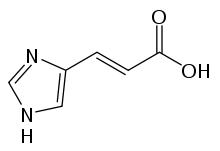Urocanic acid
Urocanic acid is an intermediate in the catabolism of L-histidine.
 | |
| Names | |
|---|---|
| Preferred IUPAC name
(2E)-3-(1H-imidazol-4-yl)prop-2-enoic acid | |
| Other names
(E)-3-(1H-imidazol-4-yl)acrylic acid | |
| Identifiers | |
CAS Number |
|
3D model (JSmol) |
|
| ChEBI | |
| ChemSpider | |
| ECHA InfoCard | 100.002.963 |
| MeSH | Urocanic+acid |
PubChem CID |
|
CompTox Dashboard (EPA) |
|
InChI
| |
SMILES
| |
| Properties | |
Chemical formula |
C6H6N2O2 |
| Molar mass | 138.124 g/mol |
| Melting point | 225 °C (437 °F; 498 K) |
Except where otherwise noted, data are given for materials in their standard state (at 25 °C [77 °F], 100 kPa). | |
| Infobox references | |
Metabolism
It is formed from L-histidine through the action of histidine ammonialyase (also known as histidase or histidinase) by elimination of ammonium.
In the liver, urocanic acid is transformed by urocanate hydratase (or urocanase) to 4-imidazolone-5-propionic acid and subsequently to glutamic acid.
Clinical significance
Inherited deficiency of urocanase leads to elevated levels of urocanic acid in the urine, a condition known as urocanic aciduria.
An important role for the onset of atopic dermatitis and asthma has been attributed to Filaggrin, a skin precursor of urocanic acid.[1][2]
Function
Urocanic acid was detected in animal sweat and skin where, among other possible functions, it acts as an endogenous sunscreen or photoprotectant against UVB-induced DNA damage. Urocanic acid is found predominantly in the stratum corneum of the skin and it is likely that most of it is derived from filaggrin catabolism (a histidine-rich protein). When exposed to UVB irradiation, trans-urocanic acid is converted in vitro and in vivo to the cis isomer.[3] The cis form is known to activate regulatory T cells.[4]
Some studies attribute filaggrin an important role in keeping the skin surface slightly acidic, through a breaking down mechanism to form histidine and subsequently trans-urocanic acid,[5] however others have shown that the filaggrin–histidine–urocanic acid cascade is not essential for skin acidification.[6]
History
Urocanic acid was first isolated in 1874 by the chemist Max Jaffé from the urine of a dog,[7][8][7] hence the name (Latin: urina = urine, and canis = dog).
See also
- Histidinemia
- Inborn error of metabolism
References
- Park KD, Pak SC, Park KK (December 2016). "The Pathogenetic Effect of Natural and Bacterial Toxins on Atopic Dermatitis". Toxins. 9 (1): 3. doi:10.3390/toxins9010003. PMC 5299398. PMID 28025545.
- Irvine AD, McLean WH, Leung DY (October 2011). "Filaggrin mutations associated with skin and allergic diseases". The New England Journal of Medicine. 365 (14): 1315–27. doi:10.1056/nejmra1011040. PMID 21991953.
- Egawa M, Nomura J, Iwaki H (May 2010). "The evaluation of the amount of cis- and trans-urocanic acid in the stratum corneum by Raman spectroscopy". Photochemical and Photobiological Sciences. 9 (5): 730–3. doi:10.1039/b9pp00143c. PMID 20442934.
- Schwarz T (December 2005). "Mechanisms of UV-induced immunosuppression" (PDF). The Keio Journal of Medicine. 54 (4): 165–71. doi:10.2302/kjm.54.165. PMID 16452825.
- Jungersted JM, Scheer H, Mempel M, Baurecht H, Cifuentes L, Høgh JK, Hellgren LI, Jemec GB, Agner T, Weidinger S (July 2010). "Stratum corneum lipids, skin barrier function and filaggrin mutations in patients with atopic eczema". Allergy. 65 (7): 911–8. doi:10.1111/j.1398-9995.2010.02326.x. PMID 20132155.
- Fluhr JW, Elias PM, Man MQ, Hupe M, Selden C, Sundberg JP, Tschachler E, Eckhart L, Mauro TM, Feingold KR (August 2010). "Is the filaggrin-histidine-urocanic acid pathway essential for stratum corneum acidification?". The Journal of Investigative Dermatology. 130 (8): 2141–4. doi:10.1038/jid.2010.74. PMC 4548931. PMID 20376063.
- Jaffe M (1874). "Ueber einen neuen Bestandtheil des Hundeharns" [Concerning a new constituent in the urine of dogs]. Berichte der Deutschen Chemischen Gesellschaft (in German). 7 (2): 1669–1673. doi:10.1002/cber.187400702225.
- Jaffe M (1875). "Ueber die Urocaninsäure" [About urocanic acid]. Berichte der Deutschen Chemischen Gesellschaft (in German). 8 (1): 811–813. doi:10.1002/cber.187500801267.
External links
- The Online Metabolic and Molecular Bases of Inherited Disease - Chapter 80 - An overview of disorders of histidine metabolism, including urocanic aciduria.